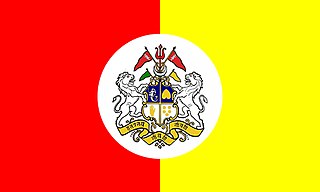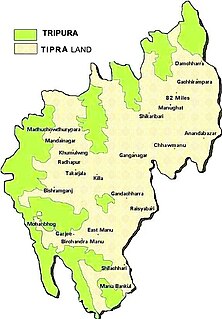Related Research Articles

The Tripuri are an ethnic group originating in the Indian state of Tripura. They are the original inhabitants of the Twipra/Tripura Kingdom in North-East India and Bangladesh. The Tripuri people through the Manikya dynasty ruled the Kingdom of Tripura for many years until the kingdom joined the Indian Union on 15 October 1949.
Rajmala is a chronicle of the Kings of Tripura, written in Bengali verse in the 15th century under Dharma Manikya I.
Twipra Kingdom was one of the largest historical kingdoms of the Tripuri people in the North-east India.

The Manikya dynasty was the ruling house of the Twipra Kingdom and later the princely Tripura State, what is now the Indian state of Tripura. Ruling since the early 15th century, the dynasty at its height controlled a large swathe of the north-east of the Indian subcontinent. After coming under British influence, it had lost some parts of kingdom present "Cumilla" and "Chittagong Hill Tracts" in Bangladesh.
Dharma Manikya II was the king of Tripura Kingdom from 1713 to 1725 and again in 1729, although his power was greatly diminished in 1732 with the rise to power of Jagat Manikya with the aid of the Nawab of Bengal, Shuja-ud-Din Muhammad Khan.

Tipraland is the name of a proposed state in India for the indigenous Tripuri people in the tribal areas of the Tripura state. They demand the Tripura Tribal Areas Autonomous District Council and some surrounding areas to be made into a separate state from Tripura. The proposed state covers 68% of the total geographical area of the Tripura and is home to over one-third of the total population of Tripura.
Pratap Manikya was a Maharaja of Tripura during the late 15th century.
Vijaya Manikya I was the Maharaja of Tripura briefly during the late 15th century.
Mukut Manikya was briefly the ruler of Tripura during the late 15th century.

Ratna Manikya I, also known as Ratna Fa, was the Maharaja of Tripura from 1462 to the late 1480s. Though he had gained the throne by overthrowing his predecessor, Ratna's reign was notable for the peace and prosperity it had entailed in the region. He extensively reformed and modernised the government and closely allied it with neighbouring Bengal, resulting in a lasting cultural influence in Tripura.
Dharma Manikya I, also known as Dangar Fa, was the Maharaja of Tripura from 1431 to 1462. His reign was notable for its territorial expansions as well as for his religious and cultural contributions.
Govinda Manikya was the Maharaja of Tripura from 1660 to 1661 and again from 1667 to 1676. Though viewed as a capable and successful ruler, Govinda's reign was interrupted by his temporary overthrow and usurpation by his younger brother.
Vijaya Manikya II, also spelt Vijay or Bijoy, was the Maharaja of Tripura from 1532 to 1563. Succeeding to the throne at a young age, Vijaya proved himself to be a formidable military leader, initiating a series of conquests into several surrounding kingdoms, including the powerful Bengal Sultanate. During Vijaya's reign, the might and influence of Tripura reached its zenith, leading to him being viewed as one of its greatest monarchs.
Lakshman Manikya was the Maharaja of Tripura during the mid-18th-century, though he maintained little actual power, having acted only as a puppet-monarch under Shamsher Gazi.
Narendra Manikya was the Maharaja of Tripura from 1693 to 1695.
Ratna Manikya II was the Maharaja of Tripura from 1685 to 1693 and again from 1695 to 1712.
Rajdhar Manikya I, also spelt Rajadhara Manikya, was the Maharaja of Tripura from 1586 to 1600. Formerly a warrior-prince who fought with distinction during his father's reign, upon his own ascension to the throne, Rajdhar showed little interest in such matters, instead becoming occupied with religious pursuits. The decline of Tripura is thought to have begun during his reign.
Ananta Manikya was the Maharaja of Tripura from 1563 to 1567. A weak monarch in comparison to his predecessor, he spent his reign under the control of his influential father-in-law. He died after only a few short years of rule, potentially at the latter's hands.
Amar Manikya was the Maharaja of Tripura from 1577 to 1586.
Udai Manikya II was the Maharaja of Tripura briefly during the mid-18th-century, having laid claim to the throne during a power struggle between his relatives Joy Manikya II and Indra Manikya II.
References
- ↑ Bhattacharjee (2010), p. 33.
- ↑ Sarma (1987), pp. 38–39.
- ↑ Durlabhendra, Sukheshwar & Baneshwar (1999), p. 60.
- 1 2 3 Sarma (1987), p. 39.
- 1 2 Roychoudhury (1983), p. 14.
- ↑ Sarma (1987), p. 38.
- ↑ Gan-Chaudhuri (1980), p. 20.
- 1 2 3 4 Lahiri (1999), p. 53.
- ↑ Singh (1999), p. 8.
- ↑ Saha (1986), p. 168.
- ↑ Momin, Mawlong & Qādrī (2006), p. 81.
- 1 2 Ganguly (1985), p. 155.
- ↑ Raatan (2008), p. 145.
- ↑ Roychoudhury (1983), p. 3.
- ↑ Sarma (1987), pp. 39–40.
- ↑ Sarma (1987), p. 96.
- ↑ Choudhury (2000), pp. 501–02.